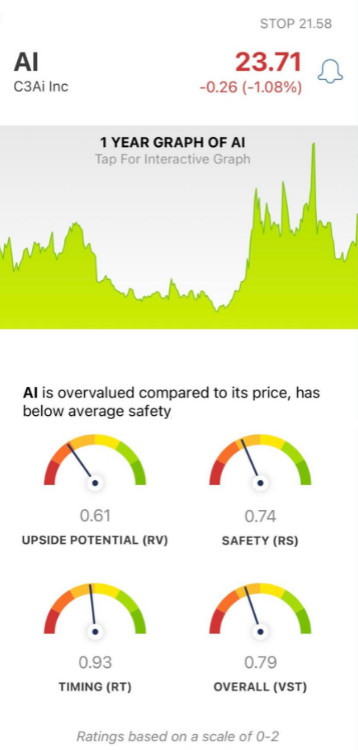20 Top Pieces Of Advice For Deciding On AI Stock Analysing Websites
Top 10 Tips For Pricing And Costing Of Ai Software For Predicting And Analysing StocksTo maximize the value of your investment, it's essential to understand and evaluate pricing on AI stock-predicting/analyzing trading platforms. Understanding what you are paying for and the price structure can be very different. This can help you make a more informed choice. Here are 10 suggestions to help you analyze the cost and price of these platforms.
1. Understanding Pricing Model
Subscription-based : Determine if there is a monthly or an annual cost, and which features are included in each level.
Pay-per-use: Make sure the charges of the platform are based on the use, like the number of transactions (or data requests), or prediction.
Freemium model: Check whether it is an initial free version with only a few functions and costs for premium features.
2. Compare Pricing Tiers
Overview of features: See what features are offered in each price tier (e.g., basic, professional, enterprise).
Scalability: Make sure your pricing levels are in line with your requirements, regardless of whether you're a solo trader or a professional.
Upgrade flexibility: Check whether you are able to easily change or upgrade your plan when your needs evolve.
3. Evaluate Hidden Costs
Data fees: Check if the platform charges extra for access to premium data (e.g. real-time data and advanced analytics).
Brokerage fees: Find out whether there are additional costs for the platform to be integrated with brokers or trades.
API usage. Determine whether there are additional costs associated with API access or high-frequency use.
4. Demos as well as Trials are Available for Free
Trial period: Look for platforms that provide a demo or free trial to test the features before you commit.
Trial limitations: Check whether the trial is free and includes all features or is restricted in terms of functionality.
There is no commitment option: If you don't like the program, you may cancel it without any charge.
5. Check out the latest discounts and promotions
Discounts on annual plans: Find out for discounts provided by the platform in comparison to the monthly plans they offer.
Referral programs: Check whether the platform offers discounts or credits for referring other users.
Prices for bulk or institutional In the event that your business is a large one it is possible to inquire about bulk and institutional pricing.
6. How do you assess return on Investment (ROI).
Cost in relation to. worth: Evaluate whether the capabilities and forecasts offered by the platform justifies the cost. Can it, for instance aid you in making a better decisions in trading or help you help you save time.
Performance track record: Research the platform's rate of success or user reviews to assess the potential return on investment.
Costs of other platforms: Compare the cost of the platform against the possible cost of not making use of it (e.g. missed opportunities, time spent on manual analysis).
7. Review and review cancellations and refunds Policies
Policy on cancellation: Make sure you are able to cancel your subscription without penalty, or with no hidden charges.
Check the policy on refunds to see whether you are eligible for a refund for any unredeemed subscription portion.
Auto-renewal: Check whether the platform auto-renews your account and the best way to decide to stop it.
8. Assess Transparency in Pricing
A clear pricing page Ensure whether the website has a pricing page which is precise, clear, and does not include any hidden fees.
Support for customers: Contact customer support to clarify any unclear pricing details or any additional charges.
Terms of service: Read the conditions of service to be aware of the long-term commitments and penalties.
9. Compare with Competitors
Comparing the features and prices of platforms with their competitors will allow you to get the most value.
User reviews: Read user feedback to find out if the platform's cost is worth it.
Market positioning: Check if the platform is priced as an expensive, mid-tier or budget option and whether it aligns with your expectations.
10. Calculate Long-Term Costs
Price increases Look through the platform's history to find out the frequency of raising prices.
Additions to features: Check whether you have new features in your current plan or need to be upgraded.
Costs for scaling: Ensure that the platform's price remains affordable in the event that your trading activities or data requirements increase.
Bonus Tips
Try a variety of platforms. Compare the capabilities and benefits of different platforms by evaluating their capabilities during free trials.
Negotiate pricing: If you're frequent user or a member of a larger institution, ask about special pricing or discounts.
You should look into educational tools and resources. Many platforms provide tools or educational materials which could be great additions to their main features.
These guidelines will allow you to assess the price and cost of AI trading platforms that predict/analyze the prices of stocks. So you can select the one that best fits your budget, and offers the features and capabilities you require. A good-quality platform will offer an appropriate balance of cost and performance, which will help you maximize your trading success. Check out the best best copyright prediction site hints for website tips including chart ai for trading, chart ai for trading, trade ai, ai investment stock, ai coin price prediction, best ai trading app, ai stock predictions, ai stock market, ai stock picker, ai stock market and more.

Top 10 Tips For Assessing The Risk Management Of Ai Stock Predicting/Analysing Trading Platforms
Risk management is an essential component of any AI trading platform for predicting or analyzing stocks that helps safeguard your capital and reduce the risk of losses. A platform with robust risk management tools can aid you navigate the market volatility and make well-informed decisions. Here are the top 10 strategies for evaluating the risk management capabilities of these platforms: capabilities:
1. Review Stop-Loss and take-profit features
Levels that can be customized: Make sure the platform allows you to determine take-profit and stop-loss limits for individual trades or strategies.
Find out if you can utilize trailing stops. They will automatically adjust if the market shifts in your favor.
Stop-loss guarantees: Check to whether the platform offers stop-loss guarantee, which will ensure that your position will close at a certain price even in volatile markets.
2. Effective Tools to Assess Position Size
Fixed amount: Ensure the platform allows you to establish the size of a position based upon the fixed amount of money.
Percentage of portfolio: Check whether you can establish position sizes in percentages of your total portfolio to control risk in a proportional manner.
Risk-reward ratio: Check whether the platform can set risk-reward ratios for individual trades or strategies.
3. Make sure you have Diversification Support
Multi-assets trading: Make sure that the platform supports trading across multiple asset categories (e.g. ETFs, stocks options, forex, etc.) to diversify portfolio.
Sector allocation: Check whether your platform provides tools to manage and monitor the exposure to sectors.
Geographic diversification: Check if the platform for trading allows international markets to spread risk across different geographical areas.
4. Evaluation of Leverage and Margin Controls
Margin requirements: Ensure that the platform is clear about margin requirements when trading leveraged.
Examine if you can set limit on leverage to limit your risk exposure.
Margin calls: Check if the platform sends out prompt notifications of margin calls to avoid account liquidation.
5. Examine the risk Analytics and Reporting
Risk metrics: Ensure that the platform offers key risk indicators (e.g., Value at Risk (VaR), Sharpe ratio drawdown) to your portfolio.
Evaluation of scenarios: Make sure the platform you're using lets you simulate market scenarios and analyze risk.
Performance reports: Check whether you are able to obtain comprehensive performance reports through the platform, including the risk-adjusted outcomes.
6. Check for Real-Time Risk Monitoring
Monitoring of your portfolio: Make sure the platform allows you to track your portfolio in real-time.
Alerts: See if you are receiving real-time notifications for at risk (e.g. stop-loss triggers and margin breaches).
Risk dashboards: Ensure the platform provides customized risk dashboards that give you a complete overview of your risk profile.
7. Tests of Backtesting, Stress Evaluation
Test for stress: Ensure that the platform will allow you to stress-test your portfolios or strategies in extremely difficult market conditions.
Backtesting - Check to see the platform you use allows you to backtest strategies with historical data. This is a fantastic way to assess the risks and determine performance.
Monte Carlo Simulators: Verify whether the platform uses Monte Carlo models to model possible outcomes and evaluate risks.
8. Evaluation of Compliance with Risk Management Regulations
Compliance with the regulatory requirements: Ensure the platform is compliant with the relevant regulations for risk management in Europe as well as the U.S. (e.g. MiFID II).
The best execution: Make sure that the platform follows the most efficient execution methods. The trades will be executed at the most affordable price feasible to limit slippage.
Transparency: Check to see if the platform discloses the risks in a clear and transparent manner.
9. Check for User-Controlled Parameters
Customized risk rules: Make sure that your platform permits you to set up your own risk management rules (e.g. the maximum daily loss, or maximum position size).
Automated risk controls You should check whether your system can implement risk management policies upon the parameters you've defined.
Manual overrides: Find out whether the platform permits manual overrides of automated risk controls in the event of emergency.
User feedback from reviewers and case research
User reviews: Examine reviews from users to assess the platform's efficiency in assessing risk.
The case studies or testimonials must demonstrate the platform's ability to handle risk.
Community forums: See whether a platform is home to a community of users who want to share strategies and suggestions for managing the risk.
Bonus Tips
Trial period: Try an unpaid trial or demo to test the platform's risk management features in real-world situations.
Support for customers: Ensure whether the platform provides solid support for issues or questions relating to risk management.
Educational resources: Discover whether your platform provides educational materials or tutorials that explain risk management practices.
These tips will help you evaluate the risks management options that are offered by AI platform for predicting or analyzing stocks. You'll be able to select a platform that will safeguard your investment while limiting possible losses. Risk management tools that are reliable are vital for trading in volatile markets. View the recommended ai day trading hints for site recommendations including chart analysis ai, ai trading bot, ai trade, best ai for stock trading, ai for stock trading, ai stock trading, ai trading platform, artificial intelligence stocks, ai stock trading app, best ai trading platform and more.
